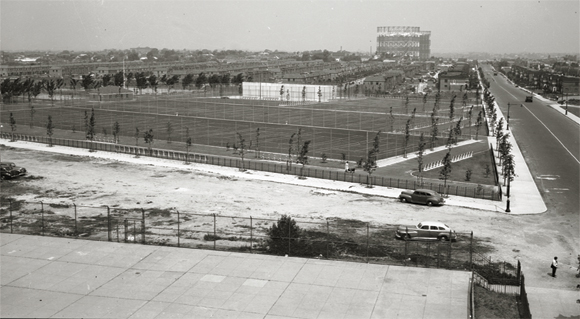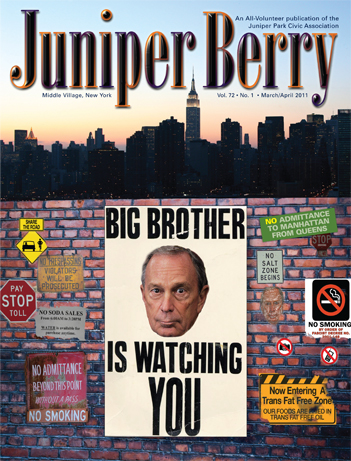We walk through its tree-lined paths on a beautiful spring night after dinner. We walk briskly around its perimeter to keep our New Year’s resolutions of staying fit and healthy. We gather at the top of its biggest hill, one of the highest points in the Borough of Queens, to watch the fire works across the river on the Fourth of July and then slide down that same hill after the first major snow fall of the season. Maybe some of us even take it for granted, but Juniper Valley Park has been, and always will be, one of the defining features of Middle Village.
And as she turns 70, we begin to realize that like fine wine, Juniper Valley Park gets better with age.
Juniper Valley Park means different things to all of us, and we all use the park in our own ways; however, do we ever stop to think of how the park came to be one of our best friends in the neighborhood? Well, it just so happens the park has a pretty colorful, even scandalous, past.
The park started out as the Juniper Swamp; a 100-acre swamp that formed from the run-off left behind by melting glaciers; the same glaciers that formed Long Island. The swamp was surrounded by beautiful, towering Juniper and white cedar trees; hence its name, and was abundant in peat bogs that were subsequently harvested. In the 1800s the park was mostly used for farming purposes. Thomas Pullis used the park for farmland and established his family cemetery in the park in 1846; the same cemetery that can be seen still today. However, at the turn of the 20th century, the purpose of the park was about to drastically change.
Gambler Arnold Rothstein
Notorious gambler Arnold Rothstein purchased the park in the early 1920s with high hopes of turning it into a moneymaking scheme. Rothstein constructed what is now known as the “phantom village” on the grounds of the swamp; 143 homes that were nothing more than empty shells with the hopes of making the swamp desirable and worth more. After building his phantom village, Rothstein attempted to sell the park to the city of New York to use as an airport; obviously to no avail. As a true moneymaking, or should I say money-scheming man he also constructed a racetrack on the swamp; the Metropolitan Heights Fairground. The racetrack was 7/8 of a mile long and was situated where the tennis courts are today. Automobiles, dogs, horses and motorcycles were raced at the track, and the track was a popular source of entertainment with five grandstands and a brass band that would play to entertain the crowds. Soon later, Rothstein was murdered in 1928 and the City of New York purchased the swamp in 1931 with the intentions of turning it into a public park.
Since the park was acquired by the city in 1931, it saw many changes and updates until it finally became the 55-acre park we know today.
A briefsummary of the history of the park is as follows: in 1942 the park debuted, due to the Works Progress Administration, with eight tennis courts, four baseball fields, a handball court, sprinklers and a wading pool all east of 76th street; by 1967 west of 76th street was developed with more baseball fields, a track, soccer and football fields and parking lots (that would soon be shut down); and from the 1980s through 2000s the park has been rehabilitated and rejuvenated due to the enormous efforts of former Councilman Thomas V. Ognibene and our very own Juniper Park Civic Association.
After the park’s completion in 1967, it fell into disrepair as it was neglected due to lack of funds. This is where the Juniper Park Civic Association comes in to play. First, the JPCA fought a proposal to put a public swimming pool in the park. Considering a public swimming pool to be inappropriate in a residential neighborhood like ours with no adequate transportation facilities, the JPCA fought the proposal and won.
The Rebirth of Juniper Valley Park
Then, in the late ‘80s Robert Holden, current president of the JPCA, saw the park in disrepair and decided to rehabilitate it. With the help of the JPCA and then Councilman Ognibene in the early ‘90s, Juniper Valley Park took its first steps towards becoming the park we know today in 2011.
The first step was to implement a curfew for the park that would be enforced by the police to discourage unsavory behavior that took place after dark. The next step was to get rid of the parking lots. There were two parking lots that were part of the park; one each on the North and South sides of the park. The JPCA and Juniper Berry’s very own Lorraine Sciulli was fundamental in closing them. The parking lots played host to vandalism, all night drinking parties, drug dealing and prostitution and with little help for any kind of control from a scaled down police department a plan was devised to rid our neighborhood of such activities. Sciulli, with the guidance of then Councilman Arthur Katzman and our very own Juniper Park Civic Association, drafted a petition to close the parking lots and her request was granted in 1977; restoring peace to Middle Village.
Next came the crucial involvement of Councilman Tom Ognibene in the rehabilitation of the park. The councilman secured millions of dollars to pour into rejuvenating Juniper; the restorations saw new baseball fields, a roller hockey rink, a rubber running track with new bleachers and a turf soccer and football field. Since the renovations, the JPCA, guardians of Juniper, has been working very hard to maintain the park and keep it in great shape. It is able to service the park with monies provided by the Juniper Valley Park Conservancy, keep all facilities in tip-top condition and offer a summer concert series in the park.
Juniper Valley Park is the heart of our neighborhood; the social pulse of our community, and without the JPCA, Councilman Ognibene and even Arnold Rothstein, the park wouldn’t be what it is today; an oasis of trees, sports facilities and passive activity which provides something for all people.
Happy 70th Birthday Juniper Valley Park, and we look forward to many more years of enjoying your bucolic contribution to our great community.
Special thanks to Joanne Amagrande and Christine Benson of the NYC Dept. of Parks for providing the early photos of Juniper Valley Park for this article.




